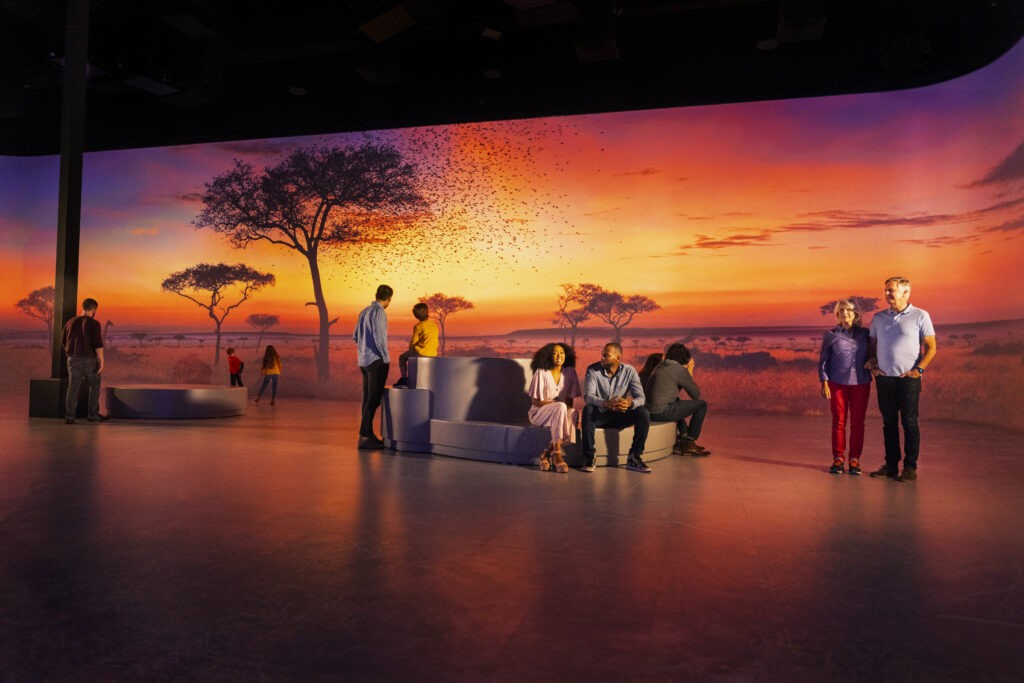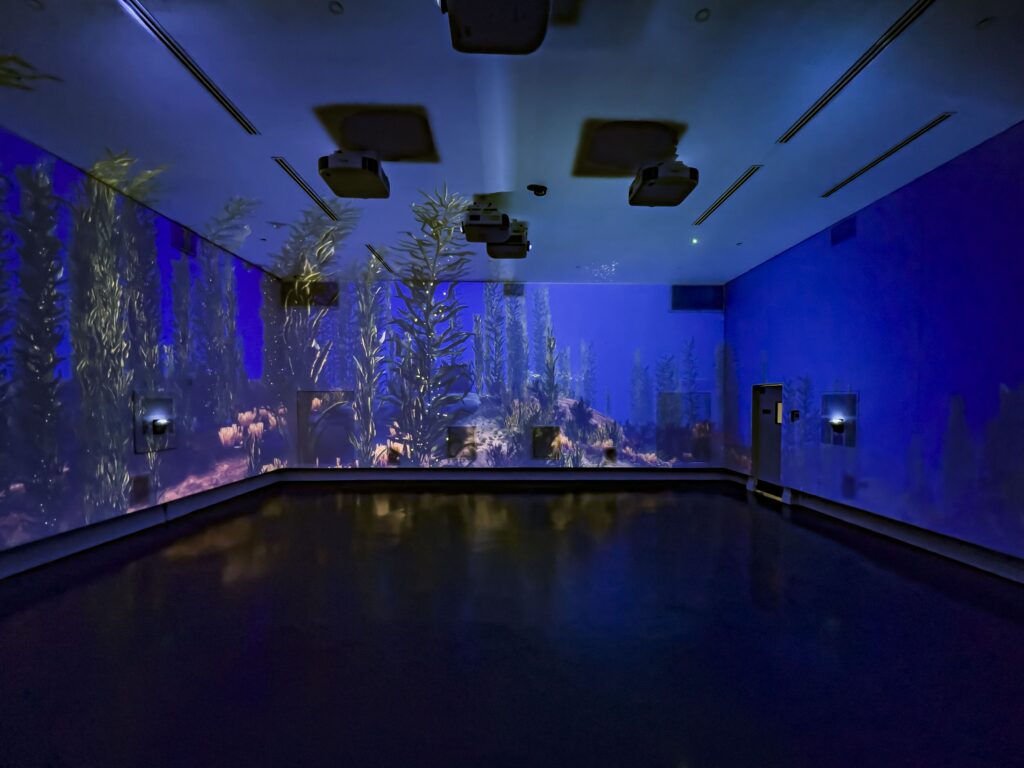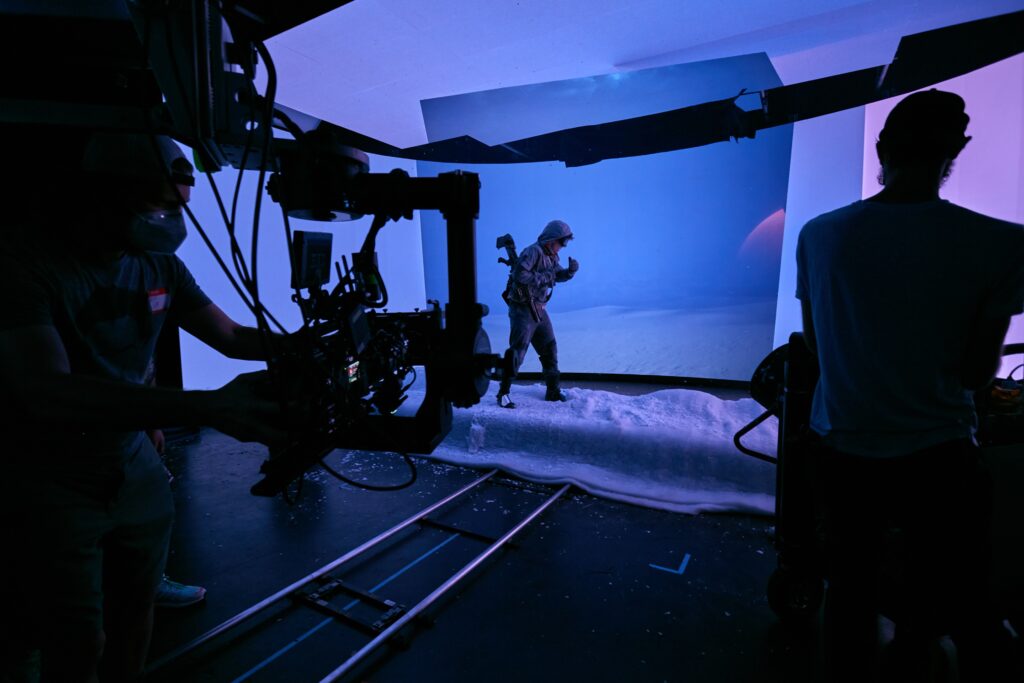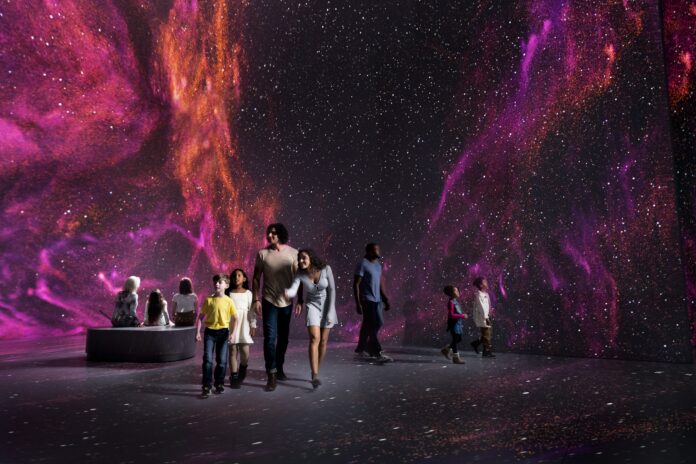disguise servers power Illuminarium venues in Atlanta and Las Vegas
by Martin Palicki & Judith Rubin
Illuminarium Experiences is a digitally-delivered, global experiential entertainment brand that creates, produces, markets and manages immersive entertainment spectacles. An Illuminarium spectacle uses projection-mapped content of more than 16 times the resolution of 4K to immerse visitors in other worlds.
The experience is like VR in a 360º environment but without needing wearable hardware of any kind. It was developed with a suite of new technology including scenting systems, sound systems, lidar sensors, video transfer systems, in-floor haptics, projectors and an army of media servers provided by disguise.
In July 2021, the first Illuminarium opened in downtown Atlanta with the debut projection-mapped spectacle “WILD: A Safari Experience.” It showcases Africa’s most exotic animals captured by 240º native field-of-view custom camera arrays that transport visitors to a safari.
Designing the experience
Creating an experience like this required an immense amount of pixel power. The Illuminarium main show room has an overall 37243 x 2100 pixel canvas, so producing a single rendered piece of content at that resolution, while also targeting 60 fps (frames per second) content and HDR workflows, meant rendering a huge amount of pixels. Currently, media servers powering 46 4K outputs push 174 million pixels of content that is regularly updated.
In order to achieve the rendering of content at this scale, as well as allow for the ability to replicate the setup across other venues, the team established a technical workflow process that could work for the creatives and scale repeatedly for the reels of content that have been on display since the opening of the venue.
The Illuminarium team also built a 1:1 mock-up of the room in one of the content offices to see what the experience might feel like. Shrinking the size of the space allowed the team to lay out the end experience in 3D and design for a horizon line that would feel correct. They even placed miniature figures in the space to give a sense of the room being populated by 50-200 people.
This mock-up enabled disguise to test its OmniCal projection calibration system on a small scale before scaling up. As a camera-based projector calibration system, OmniCal quickly captures a point cloud of a stage or projection surface, accurately calibrates projectors to sub-pixel accuracy, and conforms pre-existing surface meshes to match reality. It allows the relationship between projection surfaces, projectors and cameras to be calibrated and understood by all systems.

The team did not want to compromise content quality during the capture and display processes, as any signal degradation in that chain would break the illusion experienced by visitors to the venue. disguise worked closely with the Illuminarium team and the system integrator, Electrosonic, to develop a solution which involved breaking up the massive content into smaller and more manageable chunks. Once the content was diced into pieces, workflows within disguise would synchronize the content and pull it all together again to play out in one coherent space that was fully synchronized.
disguise vx 4 media servers enabled Illuminarium to project 174 million pixels at 60 fps onto its walls and floors. Real-time elements, powered by disguise rx render nodes and RenderStream, enhanced the show – producing picture footprints in the sand that respond to steps (with the help of lidar motion sensors from Ouster) as audience members traversed the space.
“The sheer scale of this project and the technology required to make it happen were not attempted by many before us,” explained Brian Allen, Executive Vice President of Technology and Content Integration at Illuminarium Experiences. “Getting Illuminarium from idea to execution took us about two years – gathering the right technology partners, such as disguise, and designing a system that could deliver on this ambitious concept.”
Illuminarium expands their presence
Atlanta’s “WILD: A Safari Experience” was just the beginning for Illuminarium and disguise. Since then, both have partnered in the build and launch of a second Illuminarium venue, open since April 2022 at AREA15 in Las Vegas. A new show at the new venue is “SPACE: A Journey to the Moon & Beyond,” showcasing the wonders of the universe.
In 2022, back in Atlanta and in partnership with Secret Location, Illuminarium also presented “Waking Wonderland,” a brand-new experience themed on the classic Alice in Wonderland story by Lewis Carroll. Powered by 20 disguise vx 4 servers and 35 rx render nodes driving 4K video content, visitors are taken down the rabbit hole and into Wonderland itself through an animated narrative composed of multiple immersive environments.
The future of scalable content
The success of Illuminarium helped spotlight disguise’s unique range of capabilities and has led to new applications of their products and expertise. An example is Nightscape, a new immersive entertainment venue in Nashville, which opened in March 2022 at the city’s former 12th & Porter space, now transformed into a state-of-the-art entertainment facility.
“Nightscape uses 360° projection mapping together with real-time rendered Unreal Engine graphics to transport visitors to any time or place, real or imagined,” says disguise Technical Solutions Director Peter Kirkup. “As with Illuminarium, it leverages the ability of our hardware and software to power infinitely scalable content.”

Country music’s biggest festival, CMA Fest 2022 recently hosted a series of concerts at Nightscape’s venue with four back-to-back multi-sensory, immersive artist experiences, powered by disguise and Unreal Engine.
In addition to such projects as Nightscape and Illuminarium, disguise servers are being used for other types of entertainment, including video content seen in theater shows and live concerts as well as extended reality (xR) productions – which are changing the way graphics and special effects are done in broadcast and film productions. In the past two years, disguise servers have been powering over 600 extended reality productions in over 50 countries around the world, including LED-based virtual productions for Netflix and Amazon Prime and major broadcast coverage for the Olympics and Euro football tournaments.
This, according to Kirkup, is leading the company to the emerging metaverse. “Using disguise hardware and software, our customers have been putting on events in the metaverse,” he says. “Most recently, we launched our disguise Metaverse Labs, which are growing, global hubs of innovation that can provide the creative and technical expertise that will help our customers deliver game-changing experiences in the metaverse.”
Brands, creatives and technologists can now start taking advantage of disguise Metaverse Labs’ various services across the entire production pipeline including concept development, and content creation (photogrammetry, motion capture, volumetric capture), as well as production planning and delivery support. The new division will offer regular training days so anyone can get up to speed with new metaverse workflows and technologies.
To continue the dialogue in the themed entertainment community, disguise will have a presence at the 2022 IAAPA Expo in Orlando. Visit disguise.one. • • •
disguise’s Virtual Production Accelerator Program empowers the next generation of filmmakers
Peter Kirkup explains disguise’s mission to democratize virtual production in film and allow more people to start mastering the workflows involved.
“Often we find that virtual production training does not accurately prepare trainees for the kinds of demands they will have on a production set. This course aims to change that. Held in partnership with ROE Visual at their brand-new LED volume in Los Angeles, the Accelerator Program combines traditional classroom training with real-world principal photography, giving the trainees an accurate simulation of on-set demands. Suitable for both students and industry professionals, the program helps students ramp up their skills in volume control operations, virtual art department integration and practical shoot elements.
“Trainees will start with e-learning modules where they can learn at their own pace, then move onto classroom training for a more hands-on experience. The program ends with an Accelerator Phase where trainees spend five days in a pre-planned film shoot, in order to have the opportunity to experience multiple roles on set, including disguise operations, game engine integration, practical lighting and cinematography.”
The first round of the course begins in November 2022. Application information is available at web.disguise.one/vpa







